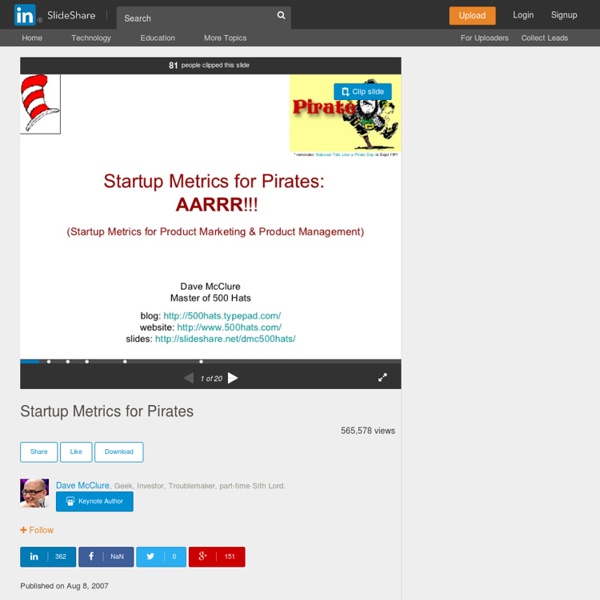



http://www.slideshare.net/dmc500hats/startup-metrics-for-pirates-long-version
Vimeo Founder Says Never Sell Your Company. Really? “An acquisition is the end of a dream.” The quote above is the title of Inc writer Issie Lapowsky’s interview with Jake Lodwick, co-founder of video sharing site Vimeo. To paraphrase Lodwick, he believes selling a business is akin to giving up - failure. 101 Must-Read Growth Hacking Resources Growing companies as quickly as possible is nothing new, but the term and interest in “Growth Hacking” has seen huge growth over the past few years. There’s never been a better time to learn how to grow and scale a company online quickly, thanks to the people who test, document and share their growth hacking experiments and results. Over the past year, we have read through more than a thousand guides on growth hacking to compile this list, which we think are the best 101 growth hacking resources out there. While you will not become a world class growth hacker by just reading these (you need to test strategies yourself!), you’ll definitely be ahead from most other online business owners if you do so. Growth Hacks
Quelles Metrics utiliser en respectant le AARRR ? - Analytics / Metrics - Growth Hacking Bonjour Antoine Perso, j'établis des scénarios de tests à différentes niveaux: Acquisition je mets en place des tests en fonction des canaux (SEO, adwords, FB, emailing, messages dans des groupes sociaux, guest blogging etcJe créé une LP différente par source de trafic et par cible de prospects. Un prospect venant d'adwords ne verra pas la même landing page qu'un autre venant d'un blog sur lequel j'ai publié un article invité
Rude VC: The misplaced pride of no marketing I heard it again just the other day during a startup’s pitch. “We’ve done no marketing, and look how much we’ve accomplished,” boasted the founders of the venture for which they were trying to raise money. Imagine what we could do if we spent money on marketing, was the intended implication of what they were saying. Unfortunately, this is not an uncommon refrain in early-stage pitches, and I cringe every time I hear it. #GrowthHacking - La définition simple - Growth Hacking - Start-Up Marketing - #⓵ Growth Hacking – Définition Simple Le Growth Hacking, quelle définition lui donner… Et bien pour commencer on va faire simple, le Growth Hacking, c’est une façon d’être, c’est un état d’esprit. De mon point de vue, on ne naît pas Growth Hacker dans l’âme, mais on le devient par passion. Cependant pour faire une courte définition, le Growth Hacking est un ensemble de techniques qui peuvent être mises en place afin de faire grandir assez rapidement un Business (En mélangeant Marketing, Développement et analyse des résultats).C’est le Marketing des Start-up.Hotmail l’a utilisé en 1996, Facebook , Dropbox, Airbnb , King (CandyCrush) également et ils sont loin d’être les seuls !
Les 5 métriques de l'entonnoir du Lean Marketing - #GrowthHacking Dans le Growth Hacking, tu l’as bien compris, ce qui est important c’est l’optimisation. Et pour optimiser, rien de mieux que de connaitre les différentes étapes qui font qu’un visiteur va devenir un client. Et pour ça, l’entonnoir du lean marketing alias le Lean Marketing Funnel en anglais est indispensable. L’importance de l’entonnoir du Lean Marketing
Daniel Marhely Technologie ouverte pour accéder à la musique à partir de n’importe quel appareilDeezer « J’ai toujours rêvé d’avoir facilement accès à ma musique, à toute la musique, même à celle des autres, n’importe où et n’importe quand », se souvient le jeune entrepreneur et développeur Daniel Marhely. En réalité, il avait une idée si précise de son rêve qu’à seulement 19 ans, il parvint à le concrétiser et à le financer à une période où l’industrie du disque paraissait se diriger vers une voie sans issue.
Agora CMS – Introduction au Growth Hacking Agora CMS, l’événement Web & CMS, dédié au chef de projet Web technique et marketing, nous a fait l’honneur de nous inviter pour la session 2013. Nous vous partageons notre présentation : Plus : Présentation Des Autres Interventions